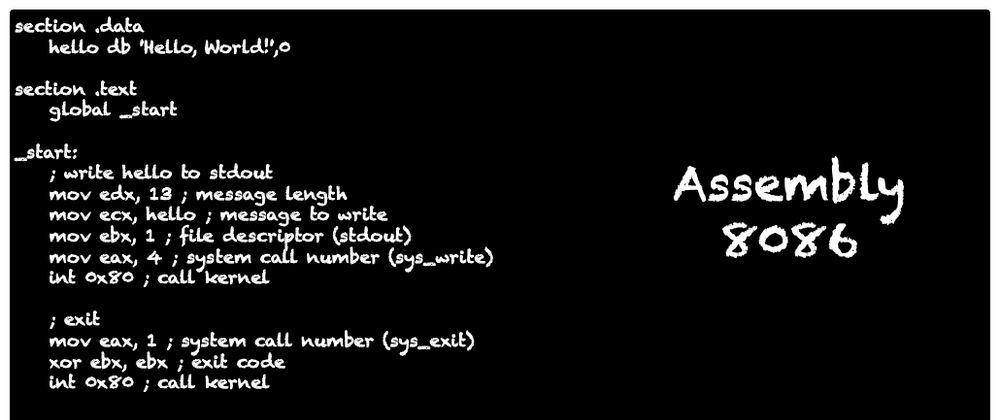If you want a mental break, give the assembly a try - it's sure to help your brain disconnect. It's also an excellent way to test your problem-solving skills, as the assembly is one of the most challenging programming languages in terms of syntax. Assembly requires a profound understanding of the hardware and computer architecture, so learning can be tricky. However, if you're looking for a challenge and want to understand how computers work at an extreme level, assembly is a great choice.
You don't believe me? Here is an example of printing "Hello, World!" in 8086 assembly language:
section .data
hello db 'Hello, World!',0
section .text
global _start
_start:
; write hello to stdout
mov edx, 13 ; message length
mov ecx, hello ; message to write
mov ebx, 1 ; file descriptor (stdout)
mov eax, 4 ; system call number (sys_write)
int 0x80 ; call kernel
; exit
mov eax, 1 ; system call number (sys_exit)
xor ebx, ebx ; exit code
int 0x80 ; call kernel
Here's an explanation of each step in the example code:
-
section .data: This line tells the assembler that the following lines will contain data that will be stored in memory. -
hello db 'Hello, World!',0: This line declares a null-terminated string "Hello, World!" that will be stored in memory. The null-terminator is necessary for the sys_write system call to know when to stop writing the string. -
section .text: This line tells the assembler that the following lines will contain code that will be executed. -
global _start: This line makes the label "_start" visible to the linker. -
_start:: This line labels the following instructions as the entry point of the program. -
mov edx, 13: This instruction loads the value 13 (the length of the string "Hello, World!") into the EDX register. -
mov ecx, hello: This instruction loads the memory address of the string "Hello, World!" into the ECX register. -
mov ebx, 1: This instruction loads the value 1 (the file descriptor for stdout) into the EBX register. -
mov eax, 4: This instruction loads the value 4 (the system call number for sys_write) into the EAX register. -
int 0x80: This instruction triggers a software interrupt, which transfers control to the kernel. The kernel will read the value in the EAX register to determine which syscall to perform, then it will read the values in the other registers to determine the arguments for the syscall. In this case, the sys_write syscall will be performed with arguments (1, "Hello, World!", 13). -
mov eax, 1: This instruction loads the value 1 (the system call number for sys_exit) into the EAX register. -
xor ebx, ebx: This instruction sets the value in EBX to 0. -
int 0x80: This instruction triggers another software interrupt and the kernel will perform the sys_exit syscall with argument 0, which will cause the program to exit.
This code is just an example and it uses the Linux syscall interface. For dos or windows you have to use different syscalls.
How to execute this code?
To execute this code, you will need to:
- Assemble the code into machine language using an assembler.
- Link the assembled code with the appropriate libraries to create an executable file.
- Run the executable on a machine that is capable of running 8086 assembly code.
Here is an example of how you might do this on a Linux machine using the NASM assembler:
1.Assemble the code:
nasm -f elf -o hello.o hello.asm
This command tells NASM to assemble the file hello.asm into an object file named hello.o using the ELF format.
2.Link the object file:
ld -m elf_i386 -s -o /app/hello /app/hello.o
This command tells the linker to link the hello.o object file and produce an executable file named hello with all symbols removed. Here the flag -m elf_i386 to specify the target architecture to the linker. This flag tells the linker to link the object file as if it's for 32-bit x86 architecture which is the architecture for 8086 processors.
3.Run the executable:
./hello
This command will run the hello executable, which will print "Hello, World!" to the terminal.
Keep in mind this is just one way to run the code, and it requires specific software and setup, that may vary depending on the platform you are using.
Also, you can use emulators such as Dosbox to run the code on modern systems.
What do you think about the syntax? Don't you think this is one of the hardest syntax to understand?
The assembly language's syntax can be challenging to learn and understand, especially for beginners. It requires a thorough understanding of the architecture and the various instructions to write code effectively. However, once you understand the syntax and the instructions, it can become easier over time.
How about you? What do you think the most challenging programming language is in terms of syntax? Let us know your thoughts in the comments below!




Top comments (0)